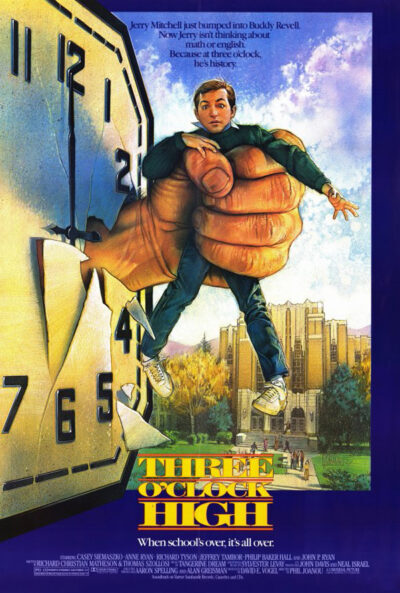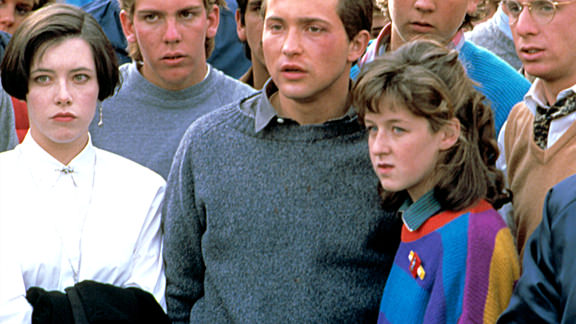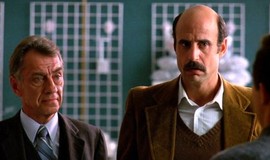 Fact: when making one of the most visually bravura directorial debuts of the 1980s—if not of all time—one really needs better material than the John Hughsian dark comedy with which first-time director Phil Joanou was saddled.
Fact: when making one of the most visually bravura directorial debuts of the 1980s—if not of all time—one really needs better material than the John Hughsian dark comedy with which first-time director Phil Joanou was saddled.
….one really needs better material than the John Hughsian dark comedy with which first-time director Phil Joanou was saddled
Joanou, just 24 at the time, was approached by none other than Steven Spielberg to direct a screenplay called AFTER SCHOOL, written by Thomas Szollosi and horror scribe Richard Christian Matheson (whose father Richard Matheson provided the script for the Joanou directed AMAZING STORIES episode “The Doll”). Spielberg was impressed by Joanou’s USC diploma film LAST CHANCE DANCE (1984), a high school set rom-com marked by bravura visuals and a trite script, thus making it an ideal lead-in to THREE O’CLOCK HIGH (the title to which AFTER SCHOOL was changed).
Spielberg produced the film but never formally lent his name, because (depending on who you ask) he was either silenced by executive producer Aaron Spelling or underwhelmed by the finished product. Hence the film, lensed in a working high school in Ogden Utah, had no recognizable names attached to it, and performed as expected in its blink-and-you’ll-miss-it October 1987 release. There’s also the fact that ‘87 was littered with John Hughes wannabes (THREE FOR THE ROAD, ADVENTURES IN BABYSITTING, CAN’T BUY ME LOVE, etc.), which explains, in part, why THREE O’CLOCK HIGH got lost in the shuffle.
Spielberg produced the film but never formally lent his name, because (depending on who you ask) he was either silenced by executive producer Aaron Spelling or underwhelmed by the finished product.
The concept is one that resonated with quite a few Hollywood bigwigs: nerdy teen Jerry Mitchell (Casey Siemaszko) gets challenged to an afterschool fight by the psychotic Buddy Revell (Richard Tyson) after touching him in a bathroom. The newly transferred Buddy hates being touched, and has been known to kill people for doing so.
Jerry tries to leave school, only to find that Buddy has messed with his car engine. He then hires a thug to beat Buddy up, stealing the money from the student store cash register and trashing the place in the process, only to have Buddy knock the thug out. Jerry finally tries to seduce his English teacher (Caitlin O’Heaney) in the hope of getting afterschool detention, but the attempt fails. Bribing Buddy doesn’t even work, meaning Jerry has to go through with the 3PM fight as scheduled.
Joanou packs the film with excellent character actors, such as John P. Ryan as the school principal, Jeffrey Tambor as a teacher, Philip Baker Hall as a detective, Mitch Pileggi as a security guard, Shirley Stoler as a secretary and Alice Nunn (PEE-WEE’S BIG ADVENTURE’S Large Marge) as a nurse; look also for a young Paul Feig (the future director of BRIDESMAIDS) in an early scene as a hall monitor. But of course Casey Siemaszko and Richard Tyson as Jerry and Buddy deserve the lions’ share of the acting credit, as they carry the film quite adequately.
The same can’t be said for the contrived and implausible script, which leaves the viewer with many an unanswered question. Why doesn’t it ever occur to Jerry to leave the school any other way than through its front parking lot? What happens with the police investigation into the trashing of the student store (which the cops seem fully aware was Jerry’s doing?)? And how does Jerry deal with the fact that Buddy messed up his car?
Joanou, at least, did his damndest to enliven the material. He has an excellent eye for detail, which extends to the titles of the books in the dean’s office and the writing seen on the classroom chalkboards. The constant ticking clock inserts (of which this film is said to hold the world record) may be a bit too numerous, but succeed in maintaining the tension.
Joanou, at least, did his damndest to enliven the material.
Crucial to the effect are the visuals of Barry Sonnenfeld, who prior to becoming a director in 1991 was one of Hollywood’s most inventive cinematographers. He’s credited as “Lighting Consultant” due to the fact that he wasn’t yet a union member, but his pictorial preferences are evident in the swooping camerawork, ultra-wide angle lenses and close-up inserts, which give the material a heightened sense of reality not dissimilar to the films of Sonnenfeld’s frequent collaborators Ethan and Joel Coen. If only it had a better script, THREE O’CLOCK HIGH might well have equaled them.
Vital Statistics
THREE O’CLOCK HIGH
Universal Pictures
Director: Phil Joanou
Producers: David E. Vogel (and Steven Spielberg)
Screenplay: Richard Christian Matheson, Thomas Szollosi
Cinematography “Lighting Consultant”: Barry Sonnenfeld
Editing: Joe Ann Fogle
Cast: Casey Siemaszko, Annie Ryan, Richard Tyson, Stacey Glick, Jonathan Wise, Jeffrey Tambor, Philip Baker Hall, John P. Ryan, Liza Morrow, Scott Tiler, Guy Massey, Theron Read, Mike Jolly, Charles Macaulay, Mitch Pileggi, E. Katherine Kerr, Caitlin O’Heaney, Vivian Brown, John Rothman, Sterling E. Gardner, Shirley Stoler, Alice Nunn, Paul Feig


